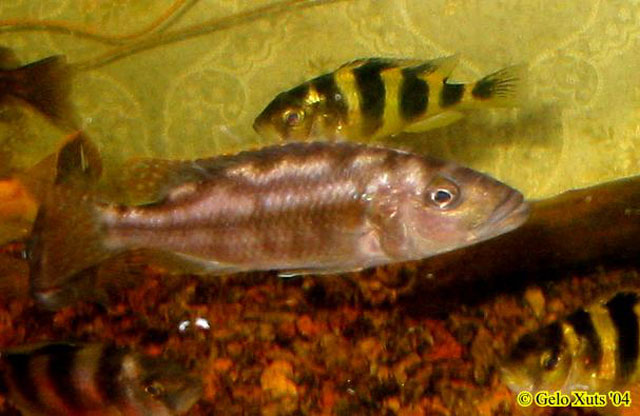| Cichlidae (Cichlids), subfamily: Pseudocrenilabrinae |
| 25 cm TL (male/unsexed); 20 cm TL (female) |
|
demersal; freshwater; depth range 0 - 15 m |
| Africa: Endemic to Lake Malawi. Occurs in the southern part of the lake, the northernmost location being Namalenje Island. |
|
Dorsal spines (total): 15-16; Dorsal soft rays (total): 11-12; Anal spines: 3-3; Anal soft rays: 10-11. Diagnosis: body relatively elongate with irregular, blotchy horizontal melanin pattern; no spots on pectoral fins; jaws large, with length of lower jaw 43.4-50.6% head length (Ref. 55922).
Description: outer and inner teeth stout and unicuspid; inner teeth slightly to strongly recurved; 3-4 series of scales on the cheek; lower pharyngeal bone normal, but relatively elongate for the genus; pharyngeal teeth sharp and widely set, stout but not enlarged; gill-rakers stout and short, the largest flattened distally and claviform or bifid; 21-27 scales in upper part of lateral line, 13-16 in lower part; 5-6 scales between pectoral and pelvic fins (Ref. 55922).
Coloration: Live: melanin pattern as in preserved specimens (Ref. 55922). Adult territorial males: body blue; anterior part of individual scales on body orange; fins blue-grey; dorsal fin with orange lappets and white submarginal band; pattern of orange-brown maculae and striae in dorsal and caudal fins more developed than in congenerics; distal part of anal fin orange-brown with large white ocelli; pelvic fin with white leading edge (Ref. 55922). Females: background color white or yellow with dark blotches; fins grey; dorsal fin lappets orange-brown; dorsal and caudal fins with brown maculae and striae (Ref. 55922). Color pattern of immature and non-territorial males intermediate between female and adult male pattern, with an increasing intensity of blue with increasing territoriality (Ref. 55922). Preserved: 4 longitudinal series of blotches: 2 dorsal series, 1 mid-lateral series and 1 ventral series; blotches more or less elongated, sometimes forming almost continuous horizontal bands, with some fusions between mid-lateral and dorsal series; base of dorsal fin along dorsum with a series of spots; general color of body and fins yellow to brown; dorsal and caudal fins with maculae; dorsal fin lappets, trailing edge of pelvic fin and ventral margin of anal fin whitish; dark stripe on the lachrymal mostly present (Ref. 55922). |
| Widespread but uncommon (Ref. 55922). Usually solitary in shallow, vegetated areas and in the intermediate sand-rock habitat (Ref. 5595, 55922). Feeds on small fishes (Ref. 5595). |
|
Vulnerable (VU); Date assessed: 22 May 2018 (A2a) Ref. (130435)
|
| harmless |
Source and more info: www.fishbase.org. For personal, classroom, and other internal use only. Not for publication.

